Pilot watches might trace their roots to military cockpits and WWII tool specs, but today they’re just as likely to show up on wrists far from the tarmac. And while some brands have turned this into a luxury category, the original appeal was always about function first. That idea still survives though if you know where to look.
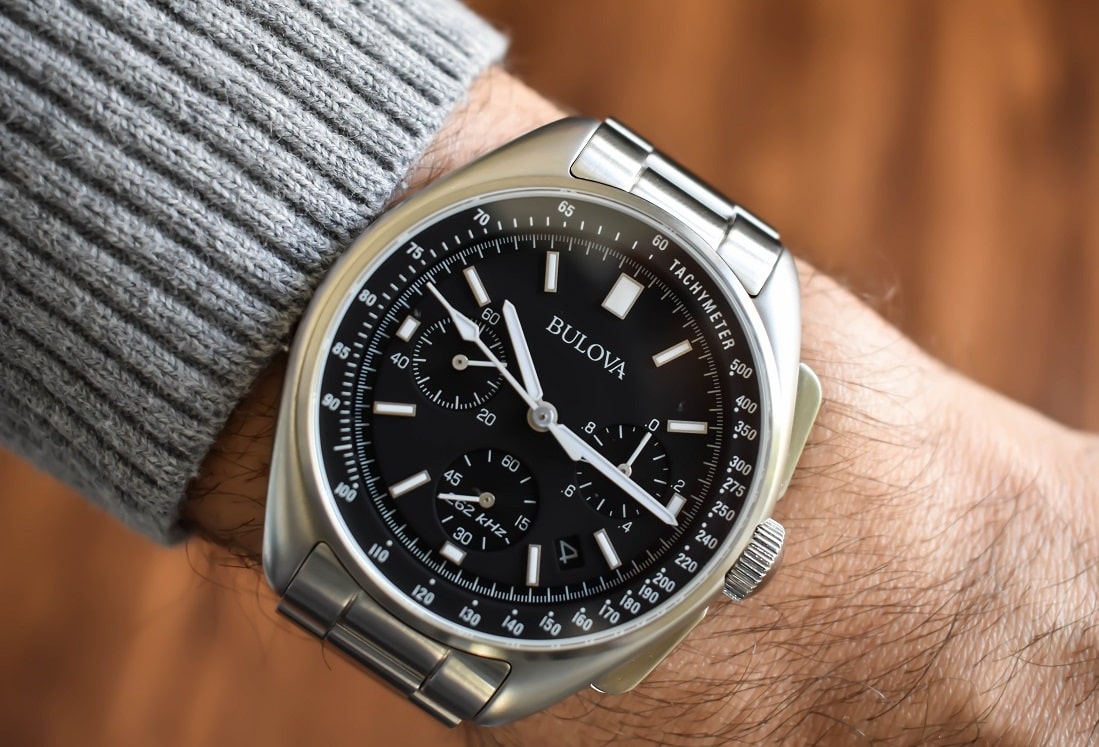
After years of hands-on testing and reviews, we’ve come to appreciate the models that stay true to the pilot watch spirit without inflating the price. What follows is a curated list of the best pilot watches for the money that we’ve actually spent time with, worn, and lived with.
San Martin Pilot Dial A
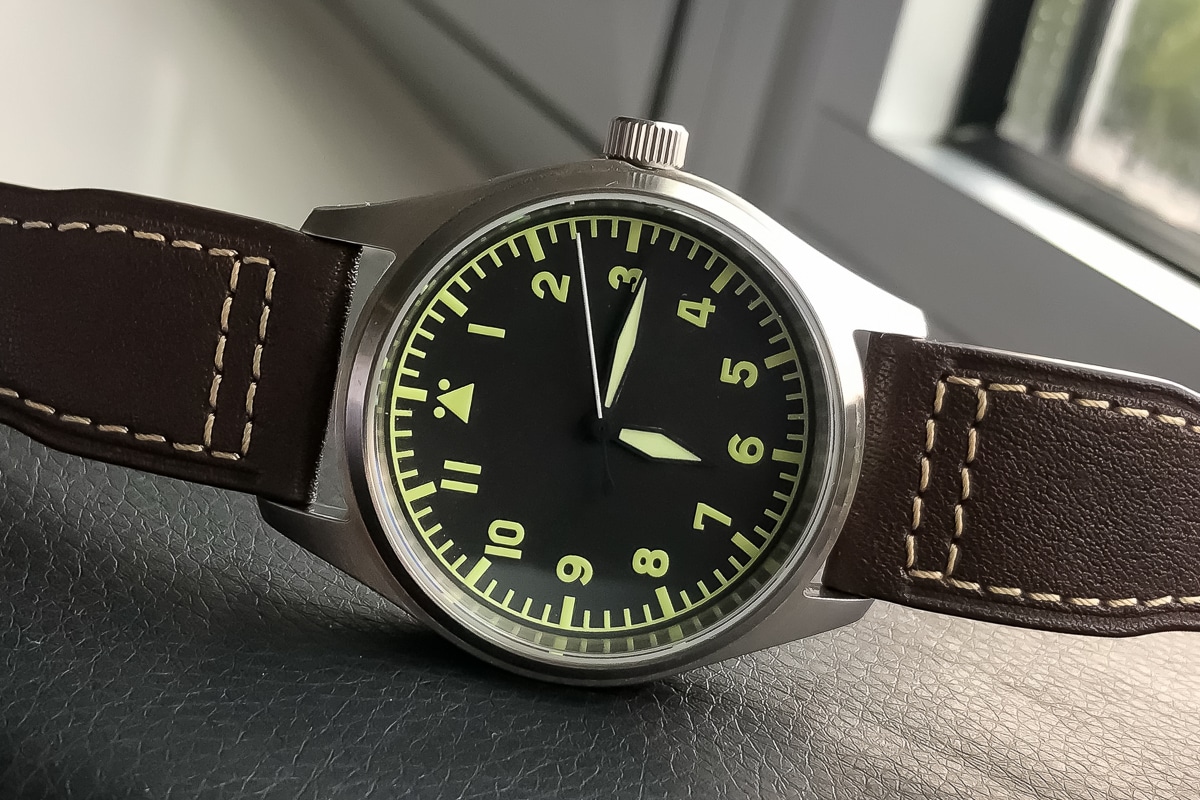
| Price Range: | $100 – $200 |
| Water Resistance: | 200m |
| Case Dimensions: | 39mm x 50mm x 12mm |
| Lug Width: | 20mm |
| Movement: | Ronda 715 |
There’s a level of intentionality in the way the San Martin Pilot Dial A wears that surprised our review team during testing. You’re getting a 39mm wide, 12mm thick case that stretches nearly 50mm lug-to-lug, but the contouring of those lugs creates a distinct wearing experience. They arc slightly down as they extend, and that curve makes the watch sit flatter than you’d expect, especially for a case that leans tall on the wrist thanks to its prominent fixed bezel. The brushing throughout the 316L stainless steel case is clean, even, and very restrained (which is appropriate for a historically inspired pilot watch design like this). There are no odd transitions in the case finish and we never noticed any edge sharpness while we tested the watch, and that’s rare at this price. The crown is nicely sized at 7mm with subtle beveling along its edges that makes it very comfortable to use. You get a secure screw-down feel without the friction or over-threading that sometimes plagues other crowns in this price segment.
Behind the sapphire crystal, we really appreciated how San Martin didn’t try to reinvent or reimagine the Type-A Flieger dial. It’s a very faithful representation of the classic design capturing all of it’s core facets. We were a bit disappointed to see that the lume on the indices and sword hands is stronger than the dial, and the quartz seconds hand gets no lume at all. It takes away slightly from the idea of the watch being fully capable in dark settings, but that’s not a hard requirement for a pilot watch. That same seconds hand doesn’t hit all the markers cleanly, either, which is a typical compromise of the Ronda 715 quartz inside. While that movement is cheap to replace and accurate enough for daily use, it does include a ghost date, since the case omits a date window entirely.
What’s funny is that we needed to make sure the leather strap we had on our watch wasn’t an aftermarket addition since it was clearly very high quality and comfortable on the wrist. The stitching is precise, the taper is just right, and the quick-release function worked exactly as it should. San Martin isn’t pushing design language forward with the Pilot Dial A. But they’ve executed a classic formula with great consistency and material quality for an extremely affordable price. Read our full hands-on review for more of our personal experience reviewing this watch.
Citizen Eco-Drive Avion
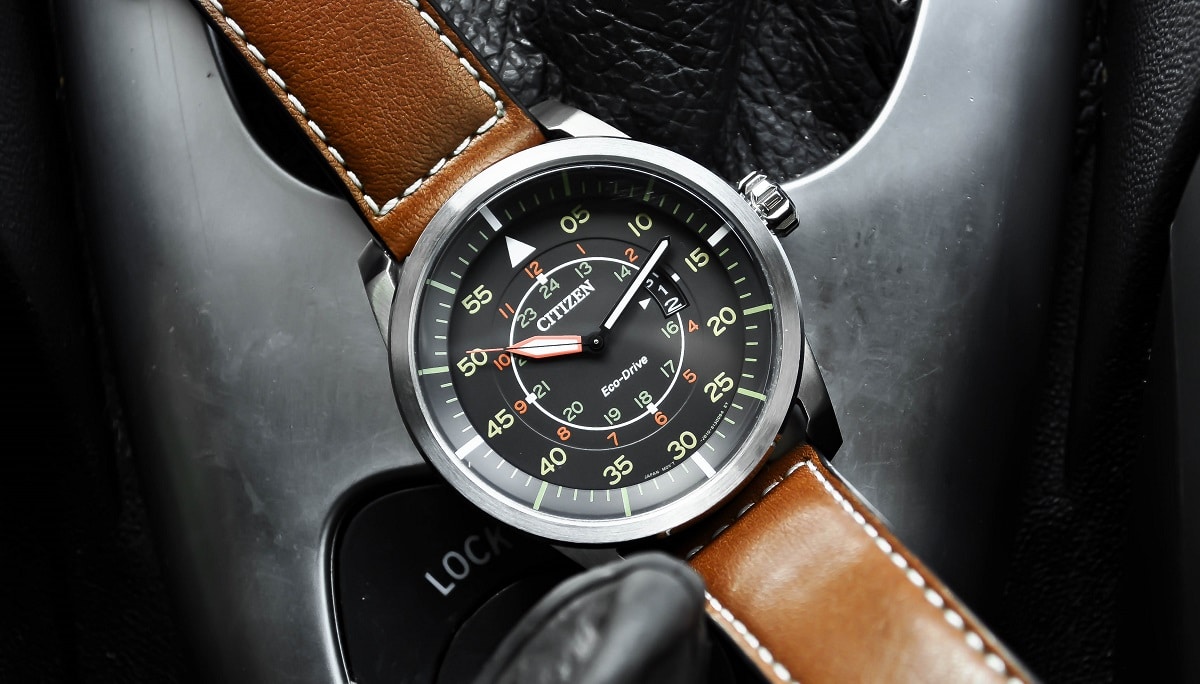
| Price: | $200 |
| Water Resistance: | 100m |
| Case Dimensions: | 45mm x 52mm x 12mm |
| Lug Width: | 22mm |
| Movement: | Citizen Eco-Drive |
What first caught our eye with the Citizen Avion wasn’t necessarily the size of the case. It was the dial’s color-coded symmetry and how effectively it makes a Type-B dial pilot watch layout feel approachable. The outer minute track in mustard yellow, inward hour ring in orange, and a muted white 24-hour scale toward center form a clean hierarchy that doesn’t overwhelm the eye but still gives you all the information you need. That clarity continues with the hands: sword-style, high contrast, and oddly charming. The hour hand in orange mirrors the hour ring, the minute hand in black stays anchored against the dial’s mid-tone gray, and the ticking seconds hand pulls a neat visual trick that we noticed during testing. It’s painted orange only beyond the white inner ring, so it reads like a small streak that only appears floating along the dial’s edge. It’s something you would typically not notice unless the watch was actually on your wrist.
Despite these positives, the lume leaves something to be desired. The hands have a bit of blue lume in them, but the dial has absolutely none. So if you’re wearing this watch in than daylight or at least a well-lit area, legibility isn’t the best. From a usability standpoint, that puts this Avion in the day-wear-only camp, which undercuts the flieger pretense a bit since some low-light legibility is expected. The case on the other hand is nails the pilot watch brief excellently. It measures 45mm wide by 52mm long, but because the case narrows inward and sits just 12mm thick, it feels more like a deep bowl than a bulky slab on your wrist. Lugs angle sharply on top but contour gently on the underside, giving the Avion better ergonomics than our review team expected at this scale. We also found the crown to be a great size and easy to operate, exactly what you’d expect from a pilot’s watch.
Powering all of this is the Eco-Drive J810 movement, which is accurate to an incredibly +/-15 seconds per month while also featuring the brand’s innovative solar charging technology. It’s dependable and virtually maintenance-free, which makes it one of the more interesting pilot watch options for someone who prefers to set and forget their watches. The included strap is stiff out of the box but as expected we found that it wears in very nicely after a couple days. For around $200, the Avion delivers an honest and slightly refreshed take on the flieger genre without pretending to be a purist’s piece. Our full review has more personal insights and hands-on anecdotes.
Seiko 5 GMT Series
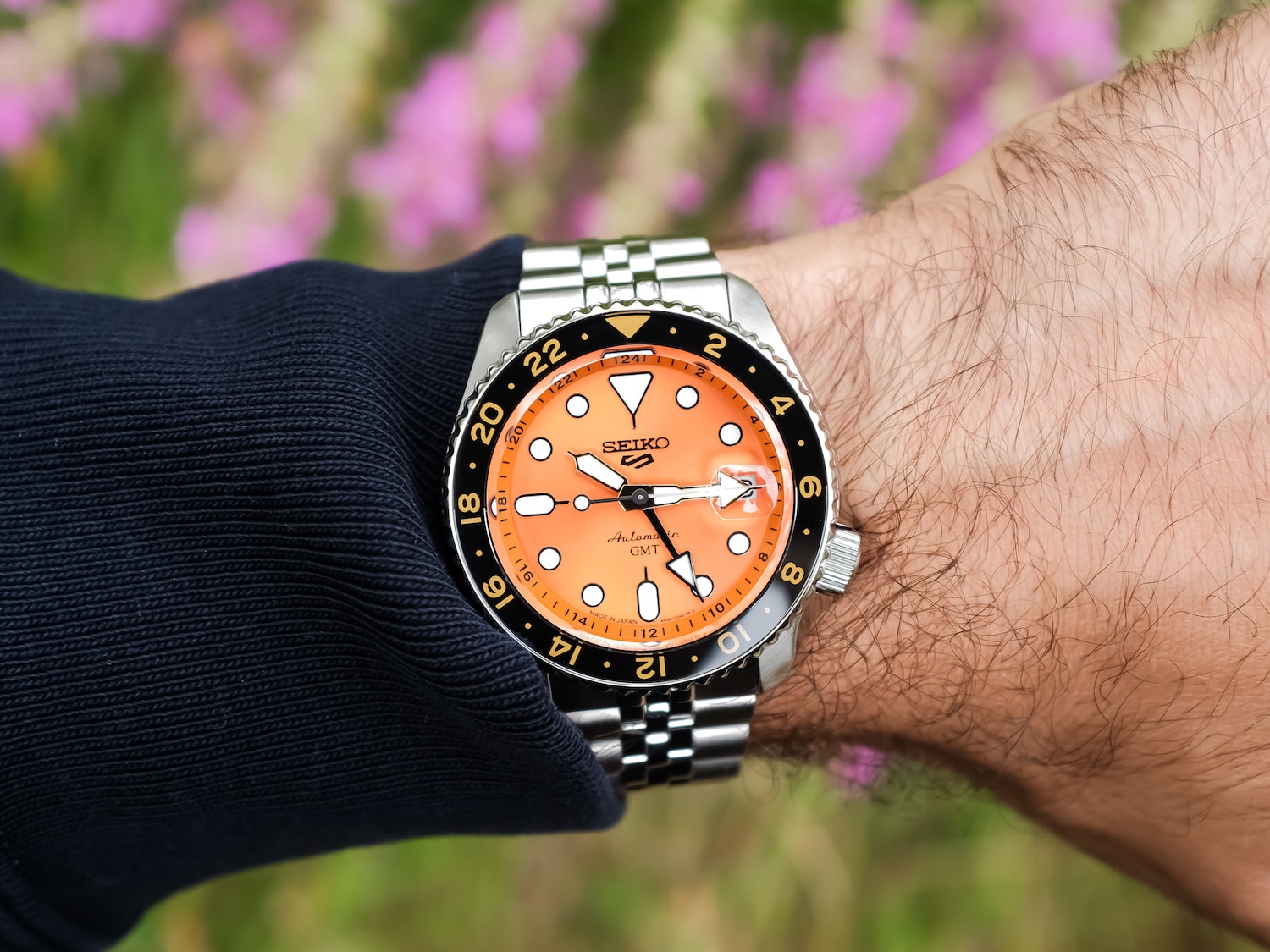
| Price Range: | $400 – $500 |
| Water Resistance: | 100m |
| Case Dimensions: | 42.5mm x 46mm x 13.6mm |
| Lug Width: | 22mm |
| Movement: | Seiko 4R34 |
The 4R34 movement inside the Seiko 5 GMT does something quite rare in this price range. It delivers a true mechanical GMT complication in a design platform that doesn’t sacrifice proportions, dial legibility, or daily usability to accommodate the function. It’s a caller-style which means the GMT hand adjusts independently while the local hour stays fixed. Plus, with the added 24-hour bezel, you’re also getting access to three time zones, which is ideal for pilots and anyone that travels a lot across time zones. Accuracy was quite steady while we conducted our hands-on test, and the movement’s 40-hour power reserve held up without issue over extended periods of time. It hacks, hand-winds, and felt just as sturdy in crown operations as any 4R movement series our team has tested.
What caught our review team and I off guard was how naturally the whole case design was able to accept the new movement complication without impacting the wearing experience. That classic SKX-style silhouette is still here at 42.5mm wide and it is balanced by the 46mm lug-to-lug span. Even with the slightly bulked-up thickness of 13.6mm (owing in part to the exhibition caseback) it doesn’t feel unstable or top-heavy on the wrist. Now the water resistance here is rated to 100 meters as opposed to 200 meters like the previous SKX generation. This is mainly due to the implementation of a push/pull crown, which some fans have criticized. But in reality we had no issues with the 100m of water resistance during our testing process and feel there is no compromise there. The bezel execution also deserves more credit than it gets. Seiko used a their proprietary hardlex material to create a glossy surface, which gives the black and grey scale a fluid sheen. We appreciated how the bezel is bi-directional and unratcheted, which is exactly what you want in a GMT bezel for quick timezones changes as you’re flying/traveling.
The dial leans into visual energy without losing clarity. We reviewed the orange dial version and its sunray finish reflects light with a level of polish that feels unexpected for this price tier. You’ll also notice how the applied indices outlined in black pair well with the thick LumiBrite coating, keeping things legible at a glance. Even the seconds hand counterweight catches the eye with a mirrored gloss finish that adds a subtle rhythm in motion. There are more hands-on photos and unique insights in our full review.
Laco Aachen 42

| Price Range: | $400 – $500 |
| Water Resistance: | 50m |
| Case Dimensions: | 42mm x 50mm x 11.75mm |
| Lug Width: | 20mm |
| Movement: | Miyota 821A |
Laco is one of the few watch brands in existence today that can claim the distinction of having shaped the modern pilot watch aesthetic. And the Laco Aachen 42 is one of the best and most affordable ways to experience that legacy through a design that stays remarkably faithful to its roots. But one thing it does do that allows it to be a bit more catered to modern standards is scale down the size. At 42mm across with a 50mm lug-to-lug span, it’s still a large watch, but still not quite oversized by vintage Flieger standards. We found that during testing the short, downward-curved lugs and the 12mm thick profile helped the watch wear flatter on our wrist than you’d expect for the diameter. The full bead-blasted finish adds strong, utilitarian character, muting reflections and matching the functional spirit of the original WWII-era B-Uhr designs.
Laco leans into that heritage with design choices that preserve function without feeling frozen in time. For example, the oversized onion crown stays true to the original pilot spec but practically speaking we found to be very easy to grip and smooth easy to operate when setting the time. The Dial layout follows the Type-B format faithfully, with large outer minute markers and a smaller inner hour track. The model we reviewed had a blue dial rather than the traditional black dial. In person the blue sunburst finish adds dimension which helps slightly modernize the watch without negatively impacting the legibility. White lume coats every marker and hand, including the full length of the baton-style seconds hand, and the matte black detailing at the hand edges keeps everything clean under varied lighting. The included grey NATO strap wears light and sits comfortably thanks to the watch’s modest weight. Plus, if you’re looking to wear the watch on multiple straps it lends itself very nicely to that by being able to accommodate a range of strap thicknesses.
Powering the watch is the Laco 21, which is their signed version of the Miyota 821A. It doesn’t hack, and there’s a ghost date click, but you get hand-winding, a 42-hour reserve, and a reliable beat rate at 21,600 bph. Accuracy isn’t chronometer-grade obviously, but this movement is a large reason why the watch is priced affordably at just over $400. If you want a pilot watch that balanced historical reference and modern wearability better than most, the Aachen 42 should be a strong consideration for you. Our full review features more personal experiences and insights on the watch.
Marathon Pilot’s Navigator
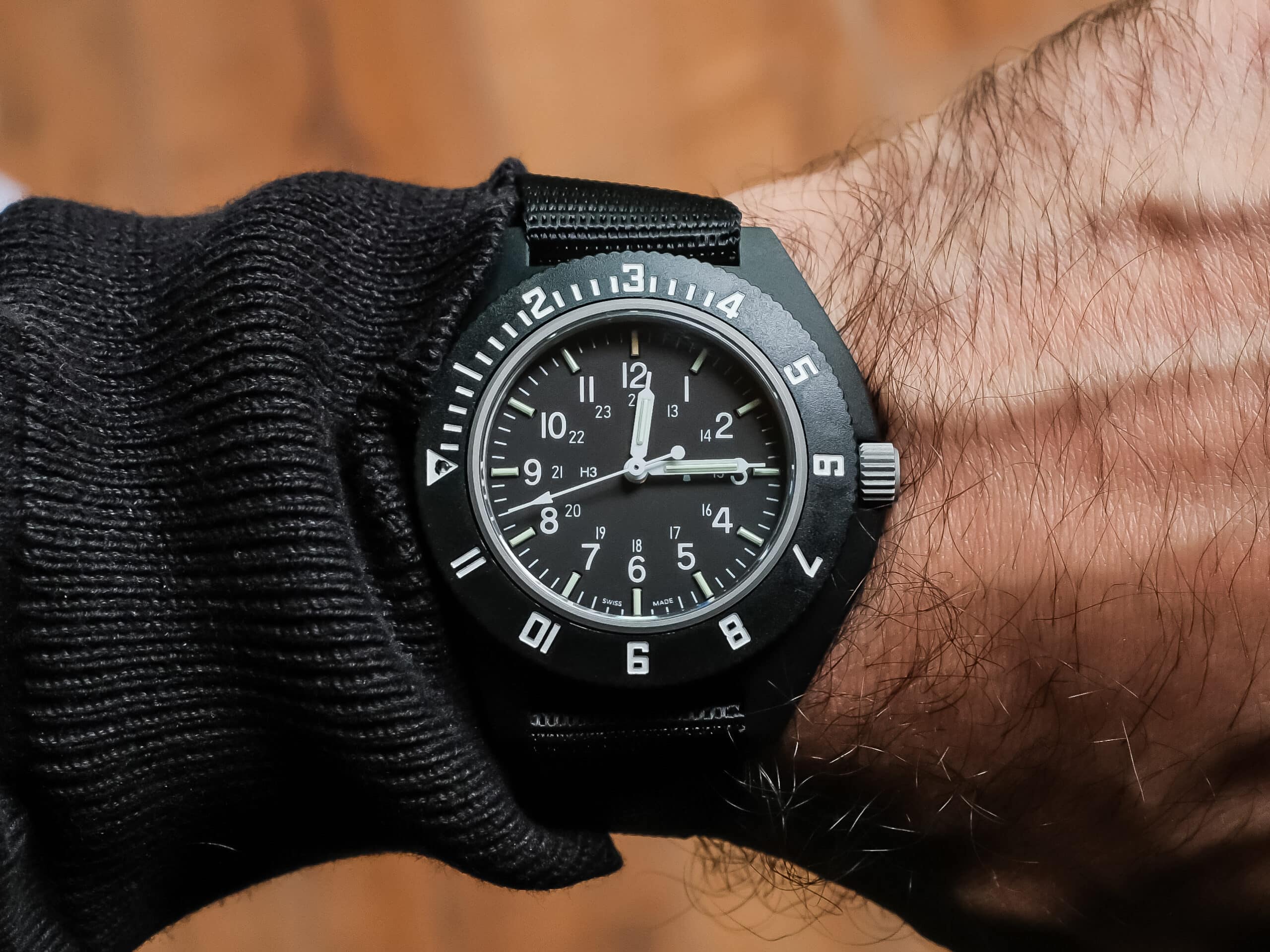
| Price Range: | $420 – $450 |
| Water Resistance: | 60m |
| Case Dimensions: | 41mm x 48mm x 13mm |
| Lug Width: | 20mm |
| Movement: | ETA F06 High Torque (Quartz) |
The dial layout on the Marathon Navigator might be one of the most function-forward we’ve ever reviewed amongst pilot watches. This particular version that we reviewed features the sterile presentation, which means there is no branding and no date. So all that is left is a high-contrast field of white markers, tritium tubes, and a full 12- and 24-hour scale. This is the kind of design that we always look forward to testing because it’s tuned for immediate functionality and usability, not just visual flair. And given that the first Pilot Navigator was designed in collaboration with Kelly Air Force base and originally only available through government contracts, that no-frills presence makes sense.
One of the more distinctive features of the watch we noticed during testing was the tritium tubes that glow continuously, eliminating the need for traditional lume and making the Navigator readable at a glance no matter the hour. The hands are also tritium tube-equipped and size for quick time reference while the spacing between scales prevents the hands from feeling crowded while maximizing information density. That level of clarity carries into the case execution as well. Marathon sticks to a 41mm composite fiber shell here with a short 48mm lug-to-lug measurement, which makes for an incredibly light and wearable frame. Total weight lands around 40 grams on a nylon strap. There’s nothing fancy in the finishing since everything is matte and unpolished, but it wears with a kind of ease and authenticity that’s hard to fake. Fixed spring bars limit your strap options, but Marathon knows the job this true modern pilot watch is built for, and NATOs or leather pass-throughs are all you really need. The bezel, though, was the one point of compromise we experienced during testing. It rotated without clicks and didn’t operate very smoothly. However, it’s still technically functional just not refined.
The ETA F06 quartz movement powers the watch and it was chosen here for its high torque to handle the weight of tritium-tubed hands. We noticed while conducting our review that the accuracy was solid throughout the experience. The Water resistance here is 60 meters, which covers most use cases that a typical issues pilot’s watch would encounter, so we didn’t feel like not having 100 meters of water resistance was an issue. For between $420 and $450, the Pilot Navigator strikes an appealing balance between authentic pilot watch credibility and affordability that few other watches can manage. For more personal experiences and insights from our time with the watch, we have a full review.
CWC Mellor 72
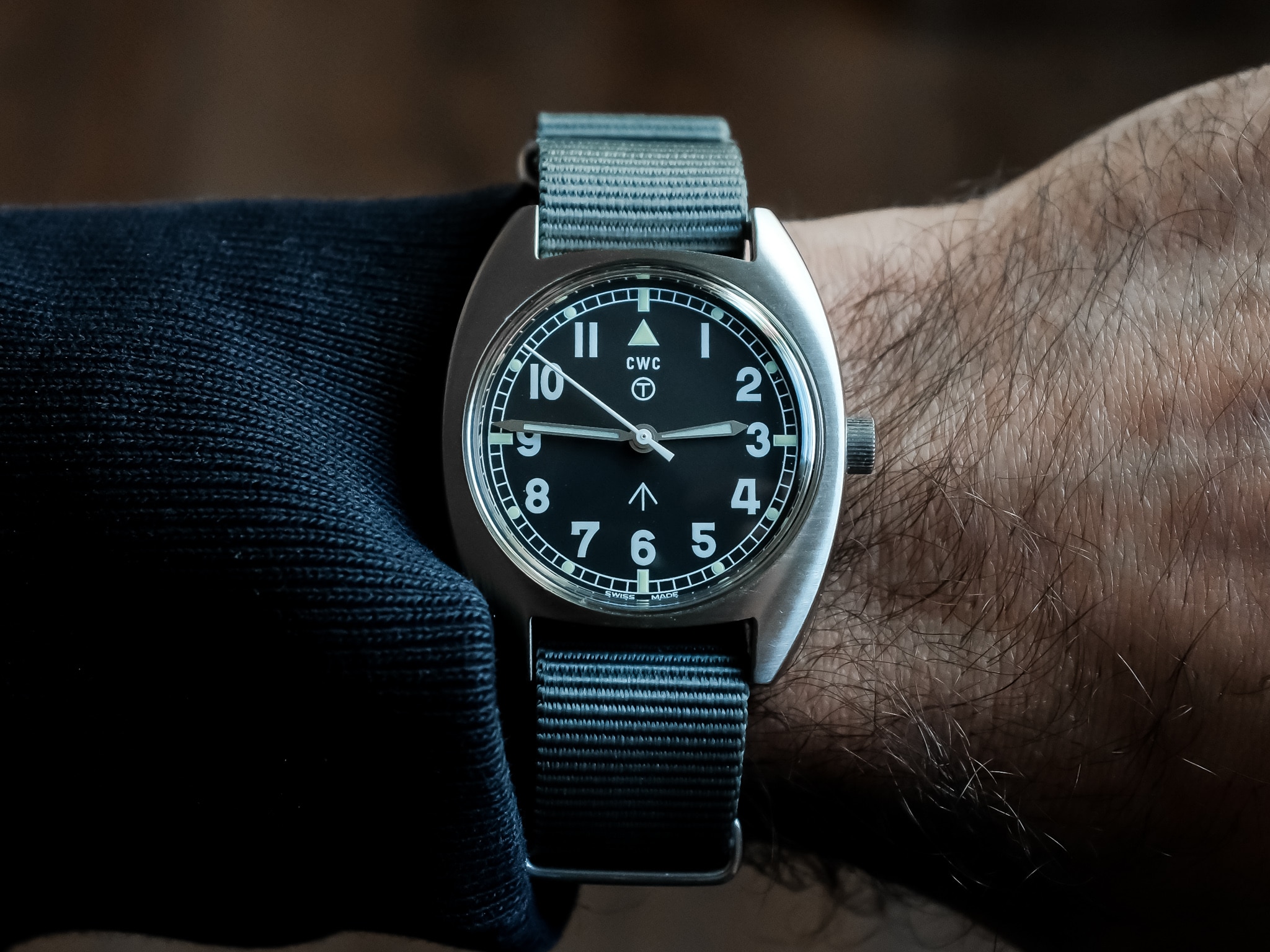
| Price Range: | $650 |
| Water Resistance: | 50m |
| Case Dimensions: | 38mm x 42mm x 11mm |
| Lug Width: | 18.5mm |
| Movement: | Sellita SW210 (Mechanical) |
The case shape on the CWC Mellor 72 does more to define the wearing experience than its modest 35mm diameter might suggest. Tonneau-like lines and brushed flat surfaces give the watch a sense of substance, even when the dimensions on paper sound small. While testing the watch on wrist, we found the 42mm lug-to-lug span and 11mm thickness (including the domed crystal) help it sit low, but the case shape and dial proportions give it just enough presence to avoid feeling too small. While the lugs do feature fixed spring bars, they are authentic to the watches military roots while also preventing spring bar failure. There’s no design flourish on the case aside from function-driven finishing, nor should there be given this watch traces its roots to the original British Military G10 which was issues to the RAF (as well as the Royal Navy and British Army).
The Mellor 72 runs on the hand-wound Sellita SW210, a reliable and easy-moving caliber that fits the watch’s vintage-military design. The power reserve is around 40 hours and we found that over the course of our review, winding it each morning felt more like a personal habit than a maintenance task. Also, unlike the one-piece cases used on some originals, this reissue has a snap-on caseback that should make servicing far easier. Of all the dials in CWC’s catalog that we’ve reviewed, this may be the most balanced. The layout follows classic British General Service specs featuring crisp white Arabic numerals on a matte black base, bordered by a clean minute track. The hand proportions are spot-on, with the minute hand reaching deep into the track to promote strong legibility. And while a painted circle-T is only a nod to the tritium-lumed originals, this reissue uses SuperLumiNova.
While the dial and movement ground the watch in its era, the included grey NATO brings it forward as an everyday tool. Lightweight, color-matched, and issued-style, it’s the right fit for a watch like this. For anyone curious about heritage pilot watches with British Military history, the Mellor 72 is a great option at around $650. Our hands-on review features more photos and personal insights on the watch.
Gavox Avidiver
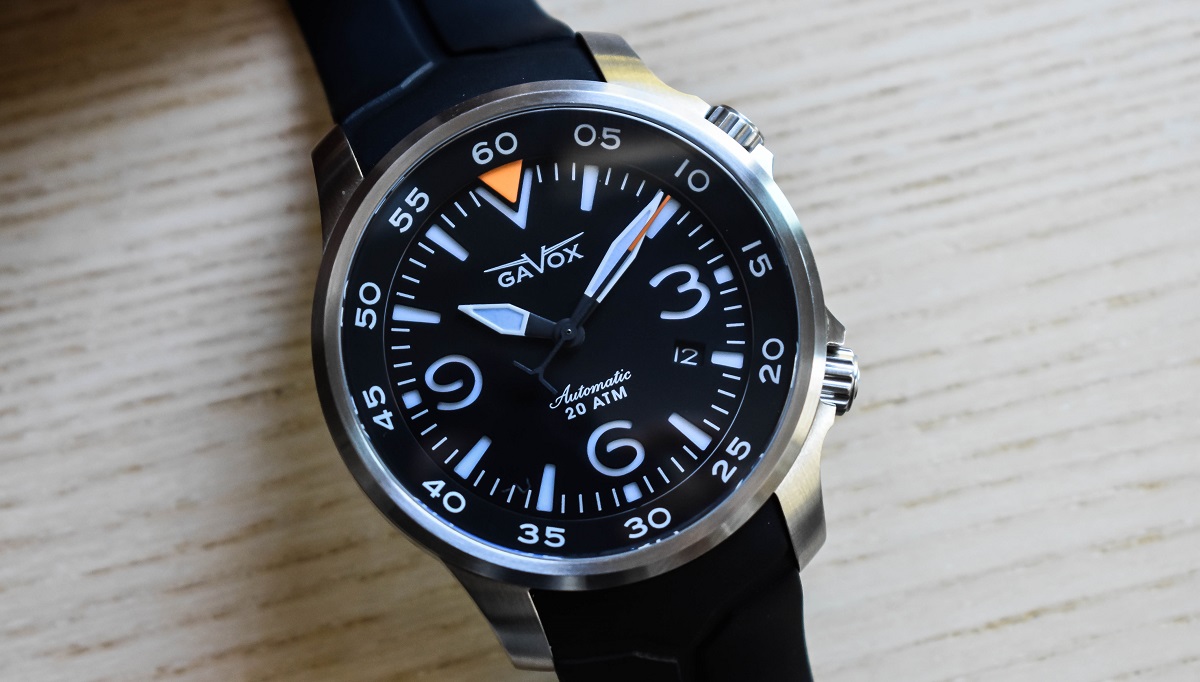
| Price Range: | $685 – $800 |
| Water Resistance: | 200m |
| Case Dimensions: | 43mm x 50.8mm x 12.8mm |
| Lug Width: | 22mm |
| Movement: | Miyota 9015 (Automatic) |
The rotating triangle inside the Gavox Avidiver dial might seem playful at first, but it’s one of the smartest timekeeping tools our review and I have come across in a pilot’s watch. Controlled by the 2 o’clock crown, the lumed triangle glides around the dial’s perimeter without clicks, allowing you to track elapsed time, run a countdown, or even log a second time zone depending on where you set it. It’s more versatile than a dive bezel and less intrusive than a full GMT scale, and it’s part of what positions the Avidiver as something more than a genre blend. That triangle sits within a multi-layer dial construction that adds real visual depth (called a “sandwich” dial). The layered effect amplifies contrast for practical legibility while the thick SuperLumiNova application makes this one of the brightest watches we’ve tested in low light.
The hands are large, sword-shaped, and styled to look like a cockpit instrument. There’s even a small date window at 4 o’clock, tucked in cleanly without disrupting legibility. Now while the case dimensions at 43mm wide and 50.8mm lug to lug may sounds like the watch would take over your wrist, the low 12.8mm thickness and curved lugs keep the size balanced and comfortable. We appreciated how in person the brushing throughout the case feels intentional, but restrained and understated, fitting the tool-first brief. It runs on the Miyota 9015, an automatic movement that performed reliably across all three review samples of the Avidiver that we tested. It offers hacking, smooth hand-winding, and solid timekeeping. The only issue we encountered was a bit of resistance when shifting between the date and time-setting positions, but that certainly isn’t a deal breaker.
The strap that comes fitted is a molded rubber design that follows the case lines closely. It’s soft, flexible, and has thoughtful touches like a signed buckle and keeper grooves to prevent the strap shifting. For between $685 – $800, the Avidiver delivers more original thinking and modern innovation to the pilot watch design than most other brands. For our full experience and unique insights, our full review is available.
Bulova Lunar Pilot Chronograph
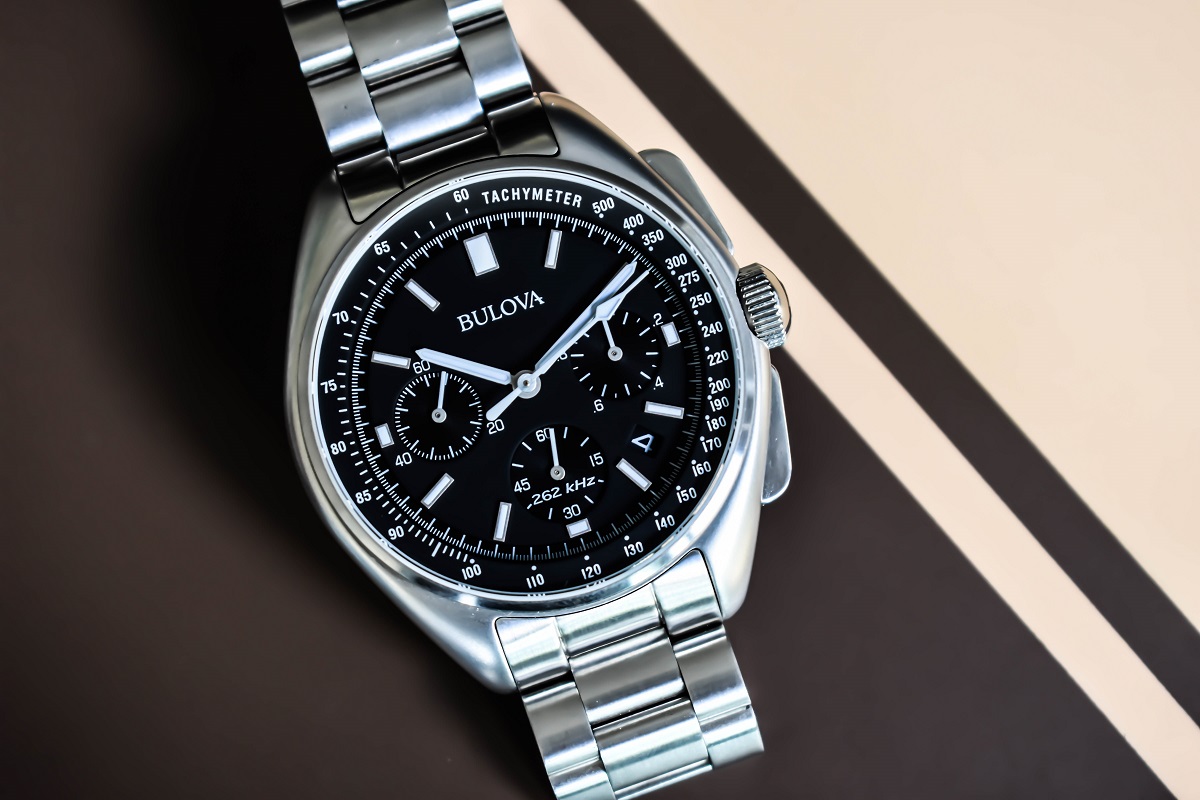
| Price Range: | $695 – $895 |
| Water Resistance: | 50m |
| Case Dimensions: | 45mm x 52mm x 13.5mm |
| Lug Width: | 20mm |
| Movement: | Bulova 262 Khz (high performance quartz movement) |
The 262 kHz quartz movement inside the Bulova Lunar Pilot is probably one of the most innovative and unique aspects of the watch you can’t really appreciate until you try it on. With a listed accuracy of +/-10 seconds per year and a sweep-style tick that runs at two beats per second, our review team found that it’s one of the affordable quartz calibers that doesn’t feel like a compromise. That high-frequency beat and smooth sweep pairs well with the layered and cleanly executed dial. From the raised black surface to the recessed sub-dials and grooved outer ring, each component is placed with such balance that we found legibility to be extremely strong during our hands-on testing. If you’ve worn many chronographs as we have you’ll appreciate how well spaced the sub-dials are in relation to the lumed applied markers. Some wearers have complained that the date placement at 4:30 is a distraction and hurts the legibility, but we didn’t experience any of that during our time with the watch.
However, all of this is contrasted with the less than ideal execution of the bracelet. Structurally, it’s excellent. There’s no looseness, the butterfly clasp closes flush, and it wears tightly to the case to create a strong wearing experience on the wrist. But the brushing on the bracelet never quite matched the soft, almost bead-blasted tone of the case. Our review team didn’t feel that the brushing on the bracelet was a deliberate, design-intended contrast. It feels a bit more like a design oversight. We even tried swapping the bracelet out for other straps. However removing the bracelet visually highlights the larger size of the watch on the wrist since it’s 45mm wide and 52mm lug to lug. The watch still wore very comfortably on the wrist though on different straps.
Prices for different Lunar Pilot models can vary but for the entry-level range you’re looking at $695 – $895, but you can find good pretty good deals on all the big retailers. Ultimately for the price, the watch offers a lot of value, innovative horological technology, and a unique touchstone for aviation history. To reach more about the history of this watch along with our personal experiences while testing it, explore our review.

Co-Founder & Senior Editor
Michael Peñate is an American writer, photographer, and podcaster based in Seattle, Washington. His work typically focuses on the passage of time and the tools we use to connect with that very journey. From aviation to music and travel, his interests span a multitude of disciplines that often intersect with the world of watches – and the obsessive culture behind collecting them.
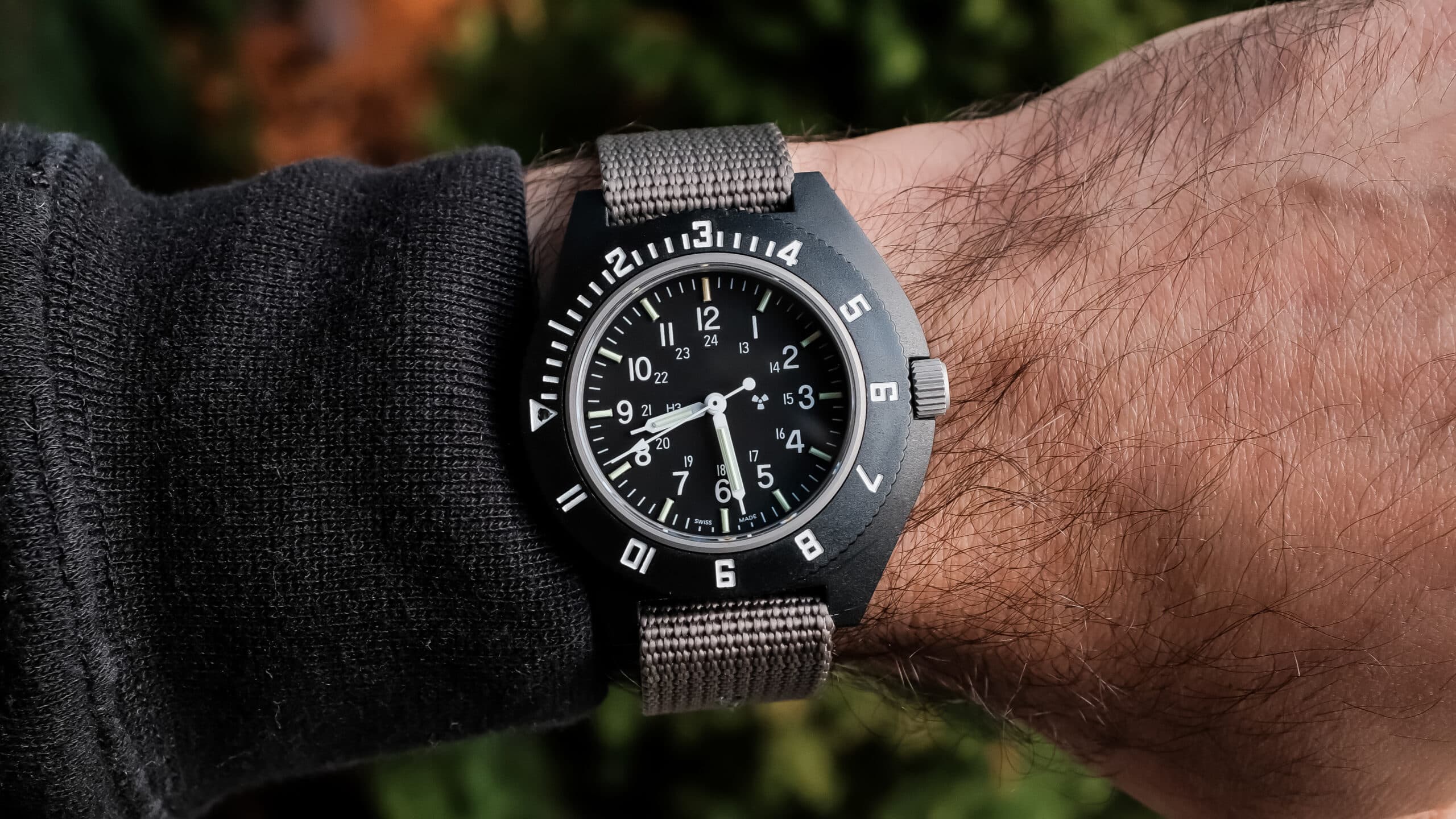
My brother is a Delta pilot (and former Navy P3 and P8 pilot) and he wears an Apple Watch when flying. He also owns a Breitling navitimer (gifted to him by his wife) that he rarely wears.
The best pilot watch that I’ve ever seen is the Damasko DC82 with a 12 hour bezel insert with the orange chrono hands on an orange robby strap. I managed to pick up that watch about 6 months back as a gift to myself following a major promotion. It is perfect. Reads like a 3 hand watch, has a 1 hour chrono that reads better than a traditional chrono, the bezel can function as a second 60 minute timer and to give UTC time. Plus it is so hard it hasn’t scratched and is anti-magnetic.
All that I need, but you could go for a DC-86 if you need a 12 hour chrono. (most stuff I time are on the matter of seconds or a few minutes).